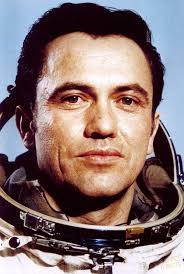Leonid Popov
Ukrainian - (RFSA)
Retired
Date of Birth: Aug. 31, 1945
Age: 79
Popov was born in Oleksandriia, Kirovohrad Oblast, Ukrainian SSR. He was selected as a cosmonaut on April 27, 1970, and flew as Commander on Soyuz 35, Soyuz 40 and Soyuz T-7, logging 200 days, 14 hours, and 45 minutes in space before his retirement on June 13, 1987.
Soyuz-U | Soyuz 35
Russian Federal Space Agency (ROSCOSMOS) | RussiaBaikonur Cosmodrome, Republic of Kazakhstan
April 9, 1980, 1:38 p.m.
Status: Success
Mission:
Soyuz 35 was the eighth mission to visit the Salyut 6 space station and carried the EO-4 expedition, which was the fourth long-duration crew for the station. The mission began on April 9, 1980, 13:38:22 UTC, launching Commander Leonid Popov and Research Cosmonaut/Flight Engineer Valery Ryumin into orbit. They docked with the station the next day. During their 186-day stay on the station, EO-4 crew conducted various scientific experiments, some repairs and replacements to the station and were visited by three uncrewed Progress cargo spacecrafts and 4 crewed Soyuz vehicles. Soyuz 35 swapped vehicles with the Soyuz 37 crew, which allowed for a longer stay in orbit. The mission concluded with a safe landing back on Earth on October 11, 1980, 09:49:57 UTC.
Low Earth OrbitSoyuz-U | Soyuz 37
Russian Federal Space Agency (ROSCOSMOS) | RussiaBaikonur Cosmodrome, Republic of Kazakhstan
July 23, 1980, 6:33 p.m.
Status: Success
Mission:
Soyuz 37 was the 11th mission to visit the Salyut 6 space station and carried the the EP-7 crew, which visited the long-duration Soyuz 35 resident crew. The mission began on July 23, 1980, 18:33:03 UTC, launching Commander Viktor Gorbatko and Research Cosmonaut Pham Tuân, the first Viatnamese cosmonaut, into orbit. They docked with the station the next day. During their 7-day stay on the station, EP-7 crew carried out some experiments. They also swapped vehicles with the resident station crew, and returned in Soyuz 36 spacecraft. The mission concluded with a safe landing back on Earth on October 11, 1980, 09:49:57 UTC.
Low Earth OrbitSoyuz-U | Soyuz 40
Russian Federal Space Agency (ROSCOSMOS) | RussiaBaikonur Cosmodrome, Republic of Kazakhstan
May 14, 1981, 5:16 p.m.
Status: Success
Mission:
Soyuz 40 was the 16th and final mission to visit the Salyut 6 space station. It carried the the EP-10 crew, which visited the long-duration Soyuz T-4 resident crew. The mission began on May 14, 1981, 17:16:38 UTC, launching Commander Leonid Popov and Research Cosmonaut Dumitru Prunariu, the first Romanian cosmonaut, into orbit. They docked with the station the next day. During their 7-day stay on the station, EP-10 crew conducted Earth observation, material, medical and other experiments, including Earth magnetic field and space radiation study. The mission concluded with a safe landing back on Earth on May 22, 1981, 13:58:30 UTC.
Low Earth OrbitSoyuz-U | Soyuz T-5
Russian Federal Space Agency (ROSCOSMOS) | RussiaBaikonur Cosmodrome, Republic of Kazakhstan
May 13, 1982, 9:58 a.m.
Status: Success
Mission:
Soyuz T-5 was the first long-duration expedition to the Salyut 7 space station. The mission began on May 13, 1982, 09:58:05 UTC, launching Commander Anatoli Berezovoy and Flight Engineer Valentin Lebedev into orbit. They docked with the station the next day. During their 211-day stay on the station, crew performed various scientific and medical experiments, and were visited by 4 uncrewed cargo Progress vehicles and 2 Soyuz missions. Soyuz T-5 crew, per usual, swapped vehicles with the visiting Soyuz T-7 crew, which allowed for a longer stay in orbit. Cosmonauts returned in the Soyuz T-7 spacecraft, landing safely back on Earth on December 10, 1982, 19:02:36 UTC.
Low Earth OrbitSoyuz-U | Soyuz T-7
Russian Federal Space Agency (ROSCOSMOS) | RussiaBaikonur Cosmodrome, Republic of Kazakhstan
Aug. 19, 1982, 5:11 p.m.
Status: Success
Mission:
Soyuz T-7 was the third mission to the Salyut 7 space station and the second to visit the long-duration Soyuz T-5 resident crew of the station. The mission began on August 19, 1982, 17:11:52 UTC, launching Commander Leonid Popov, Flight Engineer Aleksandr Serebrov and Research Cosmonaut Svetlana Savitskaya, who was the second woman in space, 20 years after Valentina Tereshkova's flight. They docked with the station the next day. During their 7-day stay on the station, crew performed various scientific and medical experiments. Soyuz T-7, per usual, swapped their vehicles with the resident Soyuz T-5 crew, which allowed for a longer stay on the station. The crew returned in Soyuz T-5 spacecraft, landing safely back on Earth on August 27, 1982, 15:04:16 UTC.
Low Earth OrbitThe Roscosmos State Corporation for Space Activities, commonly known as Roscosmos, is the governmental body responsible for the space science program of the Russian Federation and general aerospace research. Soyuz has many launch locations the Russian sites are Baikonur, Plesetsk and Vostochny however Ariane also purchases the vehicle and launches it from French Guiana.
Electron
Symphony In The Stars
Rocket Lab Launch Complex 1B - Rocket Lab Launch Complex 1, Mahia Peninsula, New Zealand'Symphony In The Stars' is the first of two dedicated missions on Electron to deploy a single spacecraft to a 650km circular Earth orbit for a confid…
Falcon 9
Starlink Group 10-34
Space Launch Complex 40 - Cape Canaveral SFS, FL, USAA batch of 27 satellites for the Starlink mega-constellation - SpaceX's project for space-based Internet communication system.
Electron
Get The Hawk Outta Here (4x HawkEye 360)
Rocket Lab Launch Complex 1A - Rocket Lab Launch Complex 1, Mahia Peninsula, New ZealandHawkEye 360 is a a space-based civil global intelligence satellite network using radio frequency (RF) technology to help monitor transportation acros…
Falcon 9
Starlink Group 10-16
Space Launch Complex 40 - Cape Canaveral SFS, FL, USAA batch of 27 satellites for the Starlink mega-constellation - SpaceX's project for space-based Internet communication system.
Falcon 9
Axiom Space Mission 4
Launch Complex 39A - Kennedy Space Center, FL, USAThis is a Crew Dragon flight for a private company Axiom Space. The mission will carry a professionally trained commander alongside three private ast…



